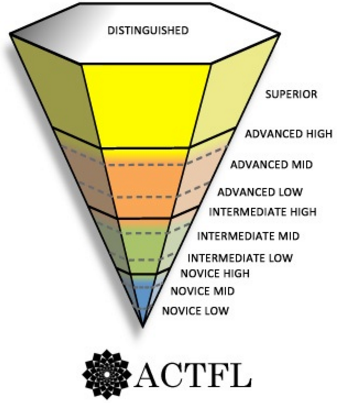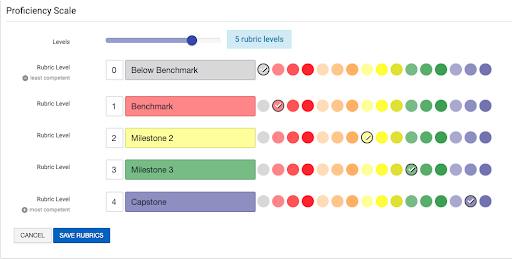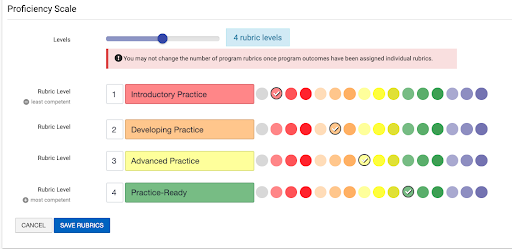As higher education leaders who are focused on supporting student learning and enabling their proficiency in requisite skills for professional practice in careers, it is important to have a common understanding of what students are learning, where they are learning it and at what level of difficulty. This is where establishing a proficiency scale that reflects realistic outcomes for students and provides data that can be used to support improvement is not only important but necessary. A proficiency scale helps in identifying where students are and where they need to be by the time they complete their programs at your institution and move on to the next stop on their learning journey.
What are Proficiency Scales for Higher Education?
Proficiency scales define the performance expected of students to reach a learning outcome. Often presented in the form of a rubric, proficiency scales represent a progression of learning goals across levels of difficulty. They can be set for an institution as well as for individual programs. For instance, an institution may set their proficiency scale linked to their institutional outcomes expected for their students upon graduation, and a program will link their proficiency scale to standards expected by an accreditation body for completing a program and indicating readiness for a career or professional practice.
The Proficiency Scale Levels for Higher Education
According to the American Council on the Teaching of Foreign Languages (ACTFL), “The Proficiency Levels are descriptions of what individuals can do with language in terms of speaking, writing, listening, and reading in real-world situations in a spontaneous and non-rehearsed context.” Although ACTFL proficiency levels are specific to language acquisition and proficiency, the key components are relevant to all proficiency levels—what individuals can do…in real-world situations.

Figure 1: ACTFL Language Acquisition Proficiency Scale
Many institutions use the American Association of Colleges and Universities (AAC&U) Valid Assessment of Learning in Undergraduate Education (VALUE) levels of learning to define their proficiency scale for general education programs or the institution at large. “From 2007 to 2009, teams of faculty experts representing colleges and universities across the United States worked together to develop 16 VALUE rubrics. The rubrics articulate fundamental criteria for the related learning outcomes and include performance descriptors demonstrating progressively more sophisticated levels of attainment.” More than 5,600 institutions across 142 countries use the VALUE rubrics as part of their assessment of college learning. The VALUE levels of learning include Benchmark, Milestone 2, Milestone 3, Capstone. Some institutions we work with will add a below Benchmark level to indicate areas of concern for learners as they begin their program.
The Importance of a Proficiency Scale for Higher Education

Figure 2: General Education Proficiency Scale Example
Defining your institutional proficiency scale should be consistent with your mission, vision and values. It also should represent what is happening in your programs. It is important that your scale reflects realistic outcomes for students enrolled in your program as well as to provide you with data to solve/identify areas for improvement. For instance, you may have a number of students who simply don’t submit assignments in their courses. This might indicate that they are not engaged, the content is too difficult or their priorities are elsewhere. Having a rubric level to help study what is happening in these cases will prove informative as you peel back the underlying reasons for non-submissions.
In a professional program like nursing education, the purpose of the program is to prepare students to be proficient, confident practitioners who are capable of serving patients and solving complex health problems. “Integrating learning while traversing a curriculum, from course to course and through clinical experiences, requires intentional design,” (Wolf, A., Carbonaro, S. & Wolf, R., 2022). In many health professions programs such as nursing, students often regard courses as discrete and are not able to thread learning experiences across multiple courses or clinical activities. Having a proficiency scale visible to students through rubrics provides the basis for learners to self-reflect on their progress and communicate their needs to advisors and faculty. Scales created in these programs also reflect what is required by professional accrediting bodies such as American Association of Colleges of Nursing (AACN).

Figure 3: Nursing Education Proficiency Scale Example
Design a Proficiency Scale to Support Student Success and Continuous Improvement
Proficiency scales can help you tell the story of your students and provide key performance indicators for use in self studies and continuous improvement plans. These scales provide the foundation for your student learning outcomes assessment as they can be linked to program learning outcomes, course learning outcomes, rubrics and the assignments that students submit.
At HelioCampus Assessment & Credentialing, our subject matter experts and client services team will work with you to set up your proficiency scales based on your assessment and strategic planning goals— scales that reflect your students needs and their progression to careers. Reach out to learn more about how HelioCampus Assessment & Credentialing can support your program design and assessment planning.
Written by:
Suzanne Carbonaro, HelioCampus
Colin Suchland, Lincoln Land Community College

